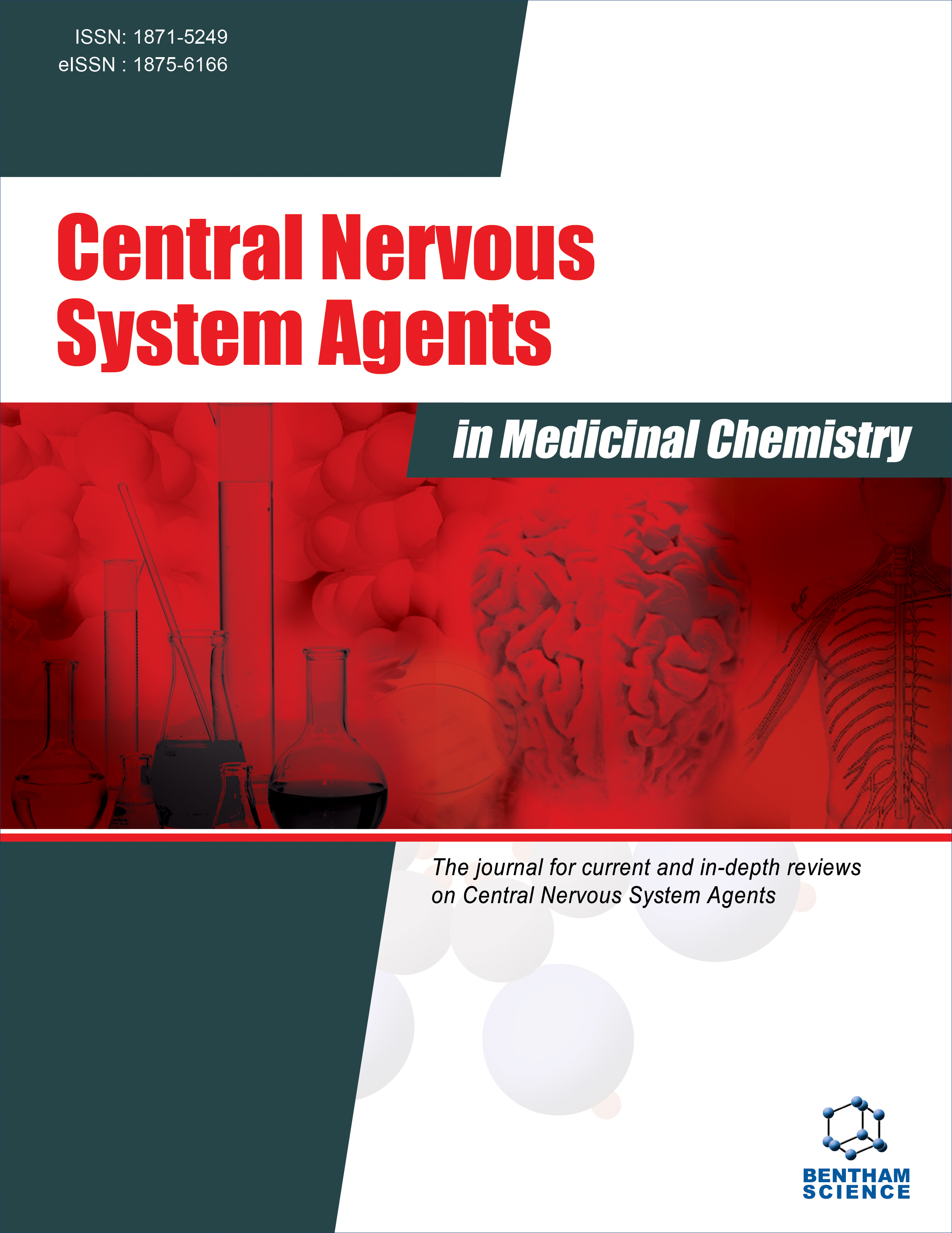- Home
- A-Z Publications
- Central Nervous System Agents in Medicinal Chemistry (Formerly Current Medicinal Chemistry - Central Nervous System Agents)
- Previous Issues
- Volume 14, Issue 1, 2014
Central Nervous System Agents in Medicinal Chemistry (Formerly Current Medicinal Chemistry - Central Nervous System Agents) - Volume 14, Issue 1, 2014
Volume 14, Issue 1, 2014
-
-
Homology Modeling of Human Kynurenine Aminotransferase III and Observations on Inhibitor Binding Using Molecular Docking
More LessAuthors: Alireza Nematollahi, William B. Church, Naveed A. Nadvi, Mark D. Gorrell and Guanchen SunKynurenine aminotransferase (KAT) isozymes are responsible for catalyzing the conversion of kynurenine (KYN) to kynurenic acid (KYNA), which is considered to play a key role in central nervous system (CNS) disorders, including schizophrenia. The levels of KYNA in the postmortem prefrontal cortex and in the Cerebrospinal fluid (CSF) of schizophrenics are greater than normal brain. A basic strategy to decrease kynurenic acid Read More
-
-
-
Variability in the Effects of Nicotine on Different Regions of the Brain: Changes in the Concentration of Superoxide Dismutase Isoforms
More LessAuthors: Adolfo Toledano, Maria-Isabel Alvarez and Adolfo Toledano-DíazPrevious studies have shown that rats subjected to subchronic treatment with nicotine experience changes in COX-2 (a marker of pro-inflammatory systems) and accumulate lipid hydroperoxides (a marker of oxidative stress) in the CNS (CNSMC, 2010; 10:180-206) (hippocampus, frontoparietal cortex and cerebellar cortex). Such changes are specific to each region since each contains different types of neuronal and glial cells wit Read More
-
-
-
Novel Agents in CNS Myeloma Treatment
More LessAuthors: Alessandro Gozzetti and Alfonso CeraseCentral nervous system localization of multiple myeloma (CNS-MM) accounts for about 1% of all MM. Treatment is still unsatisfactory. Many treatments have been described in the literature: chemotherapy (CHT), intrathecal therapy (IT), and radiotherapy (RT), with survivals reported between one month and six months. Recent drugs such as the immunomodulatory drugs (IMiDs) and proteasome inhibitors (bortezomib Read More
-
-
-
Plant Secondary Metabolites- Potent Inhibitors of Monoamine Oxidase Isoforms
More LessAuthors: Bijo Mathew, Jerad Suresh, Githa E. Mathew, Ramamoorthy Parasuraman and Nalakathu AbdullaTarget of monoamine oxidase inhibitions are considered as the treatment of depressive states and neurodegenerative disorders, including Parkinson’s and Alzheimer’s diseases. Many medicinal chemistry research groups are actively working in this area for the development of most promising selective MAO inhibitors. Many plant isolates also showed remarkable MAO inhibition in recent years. The objective of this revi Read More
-
-
-
Synthesis and Antihypertensive Activity of Novel Quinazolin-4(3H)-one Derivatives
More LessAuthors: Seema R. Pathak, Vineet Malhotra, Rajendra Nath and Kripa ShankerA series of novel substituted quinazolin-4(3H)-one derivatives were synthesized and screened in vivo for their antihypertensive activities. Out of eighteen synthesized compounds, seven i.e. 2a, 2c, 4a, 4d, 5d, 6a & 6b compounds have shown hypotensive effect and produced bradycardia. These compounds have shown better activity than reference drug Prazosin (which acts as anti-hypertensive agent by α1 blocking action Read More
-
-
-
Molecular Recognisation of 3a, 4-Dihydro-3-H-Indeno [1, 2-C] Pyrazole-2- Carboxamide/Carbothioamide Anticonvulsant Analogues Towards GABA-Aminotransferase- An in Silico Approach
More LessAuthors: Bijo Mathew and Mohamed J. AhsanConvulsion generally occurs as a result of the diminishing concentration of GABA below a threshold level in the brain. This degradation pathway of GABA is catalyzed by the γ-aminobutyric acid amino transferase. The objective of the current study is to propose the binding interaction of 3a, 4-Dihydro-3-H-indeno [1, 2-C] pyrazole-2-Carboxamide/ Carbothioamides anticonvulsant analogs with a three-dimensional structural mode Read More
-
-
-
Targeted Drug Delivery to Central Nervous System (CNS) for the Treatment of Neurodegenerative Disorders: Trends and Advances
More LessAuthors: Kritika Goyal, Veena Koul, Yashveer Singh and Akshay AnandThe treatment of brain diseases has been a major challenge since a long time. Although there are several potent drugs, which are highly therapeutic yet their efficiency is marred due to the presence of the Blood Brain Barrier (BBB). The BBB, which is present at the capillary level regulates and monitors the entry of all small and large molecules entering into the brain. Although this barrier is of immense importanc Read More
-
Volumes & issues
-
Volume 25 (2025)
-
Volume 24 (2024)
-
Volume 23 (2023)
-
Volume 22 (2022)
-
Volume 21 (2021)
-
Volume 20 (2020)
-
Volume 19 (2019)
-
Volume 18 (2018)
-
Volume 17 (2017)
-
Volume 16 (2016)
-
Volume 15 (2015)
-
Volume 14 (2014)
-
Volume 13 (2013)
-
Volume 12 (2012)
-
Volume 11 (2011)
-
Volume 10 (2010)
-
Volume 9 (2009)
-
Volume 8 (2008)
-
Volume 7 (2007)
-
Volume 6 (2006)
Most Read This Month
Article
content/journals/cnsamc
Journal
10
5
false
en


